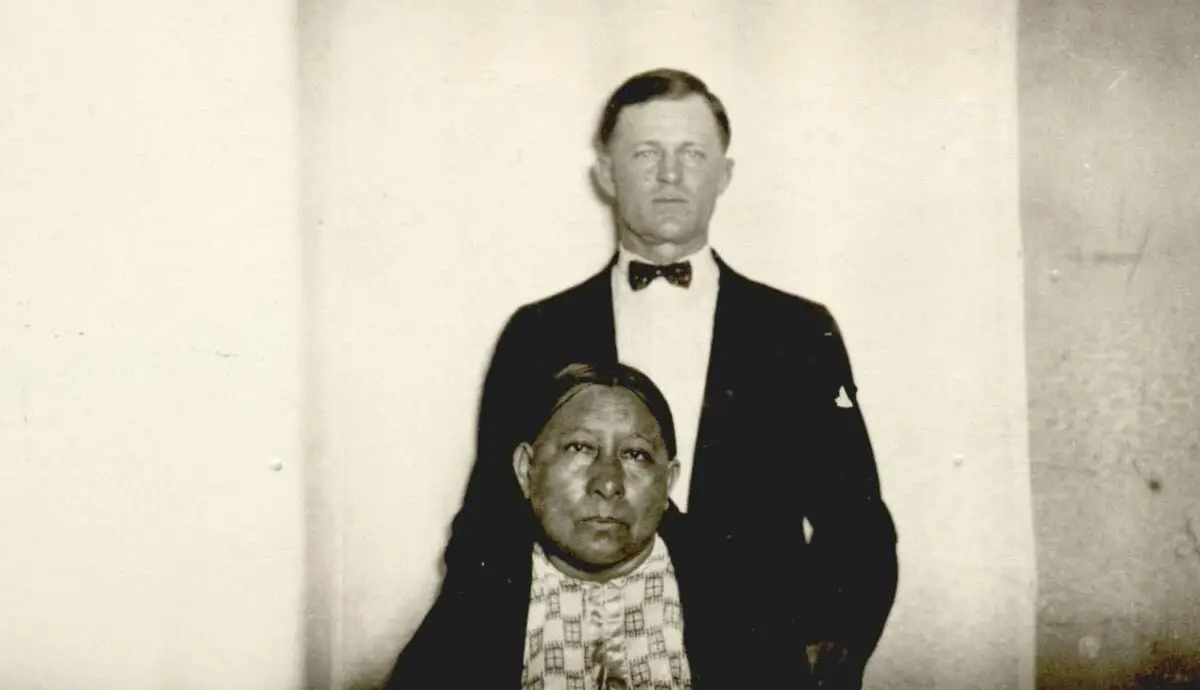Learn here about Ernest Burkhart Wikipedia, Wiki, Children, Age, Wife and more details.
Ernest Burkhart may not be a household name, but his life is a captivating and somber tale. Born in 1892, he navigated a tumultuous period in American history marked by violence and avarice. In this article, we delve into the enigmatic life of Ernest Burkhart, exploring key facets of his personal journey, age, children, and his relationship with his wife.
The Ernest Burkhart Story
Ernest Burkhart Biography
- Full Name: Ernest Burkhart
- Date of Birth: 1892
- Date of Death: 1986
- Age at Death: 94
- Ethnicity: Osage Native American
- Nationality: American
- Family:
- Father: William Burkhart (White rancher)
- Mother: Lizzie Burkhart (Full-blooded Osage)
- Siblings: Byron, Roy, Anna, Reta, Lizzie
- Wife: Mollie Kyle (Full-blooded Osage)
- Children: Cowboy (son), Margie (daughter)
Ernest’s Early Life and Diverse Heritage
Ernest Burkhart was a member of the Osage Nation, a Native American tribe, born into one of the wealthiest Osage families in Oklahoma during the early 20th century. Their wealth stemmed from oil rights, a fortune that significantly shaped his life.
His family was a melting pot of cultures. His father, William Burkhart, was a white rancher, while his mother, Lizzie Burkhart, was a full-blooded Osage. This blend of backgrounds became both a source of strength and tension in his life.
Ernest’s Family and Children
Ernest had several siblings, including brothers Byron and Roy, and sisters Anna, Reta, and Lizzie. In 1917, he married Mollie Kyle, a full-blooded Osage woman. Together, they had two children, a son named Cowboy and a daughter named Margie.
However, his family’s story is far from conventional or happy. His involvement in the notorious Osage Indian murders strained his relationships with his siblings and wife. These heinous crimes, masterminded by a white rancher named William Hale, led to the murders of numerous Osage people, including some of Burkhart’s own family members, all for their valuable oil rights.
Mollie, Ernest’s wife, eventually divorced him upon discovering his role in these murders, particularly in the death of her sisters. The trauma caused by these events had a profound impact on their family, especially their children. Cowboy witnessed the murder of his mother’s sister, Anna, as a child, and Margie grew up knowing the truth about her father’s crimes.
Ernest’s attempts to mend his family ties after his release from prison were met with resentment and resistance, serving as a poignant reminder of how one’s actions can echo through generations.
Ernest Burkhart: Age and Life’s Odyssey
Ernest Burkhart lived to the age of 94, passing away in 1986. His journey was one of complexity and contradiction. Born into wealth, his family became targets due to their valuable oil rights, leading to violence and greed defining much of his life.
Despite his intelligence and charisma, he had deep flaws, including vulnerability to manipulation. His uncle, William Hale, orchestrated the Osage Indian murders, unwittingly turning Ernest into an accomplice. This led to his conviction for the murder of his sister-in-law, Anna Brown, resulting in a life sentence. However, he was paroled after only 11 years.
In 1941, Ernest’s life took another dark turn when he was convicted of robbing his former sister-in-law, Lillie Morrell Burkhart. This time, he was sentenced to seven years in prison, with his parole revoked.
Ernest’s Wife and Relationships
Ernest Burkhart’s relationship with his wife, Mollie Kyle, was profoundly affected by his involvement in the Osage Indian murders. Her discovery of his role in the crimes led to their divorce and strained relationships with his children. This painful chapter left a lasting impact on their family dynamics for years to come.
After his release from prison in 1946, Burkhart’s attempts to reconnect with his family were met with resistance, underlining the enduring consequences of his involvement in the murders.
The Legacy and Lessons of Ernest Burkhart
Ernest Burkhart’s legacy is a complex one. He is remembered as a murderer and a con artist, yet he is also seen as a victim of his circumstances. His life serves as a stark reminder of the fragility of human behavior. Even those with intelligence and charisma can be swayed by greed and violence.
Moreover, Ernest Burkhart’s story underscores the importance of justice and accountability. Even those who commit the most heinous crimes must be held responsible for their actions.
In Conclusion
In conclusion, the life of Ernest Burkhart is a tragic and compelling tale of a man entangled in a web of violence, greed, and manipulation. His journey serves as a reminder of the enduring consequences of our actions and the necessity of justice in the face of the darkest deeds.
FAQs
Why was Ernest Burkhart Pardoned? Ernest Burkhart was pardoned because he had been serving a life sentence for his involvement in the Osage Indian murders, particularly for the murder of his sister-in-law, Anna Brown. He was later paroled after serving 11 years in prison. However, his parole was later revoked when he was convicted of robbing his former sister-in-law, Lillie Morrell Burkhart, in 1941.
Who Pardoned Ernest Burkhart? Ernest Burkhart accepted a plea deal for the murder of his brother-in-law, Rita’s husband, William E. Smith. He received a life sentence before being paroled in 1947 and was eventually pardoned by Oklahoma Gov. Henry Bellmon in 1965.
Emma Slater: Her Inspiring Journey, Marital Story, Net Worth, and Instagram – All You Need to Know
The Enigmatic Link Lauren: A TikTok Influencer with a Purpose

